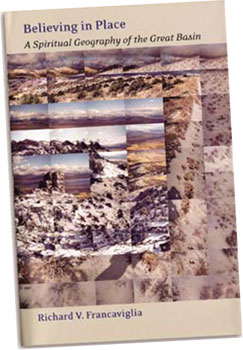| Transformed by education | Images of a championship season | Alumna saves lives in Iraq |
 |
||
| Home Forethought Campus Buzz Feature Stories Re:Search The Score Alum News Yesteryear | ||
Gazing upon the plains of North Texas, you’ve likely never pondered how the landscape has shaped your life or the lives that came before. Richard Francaviglia has. Ever since he was a boy growing up in Tucson, Ariz., he’s been fascinated with what happens to people as they are exposed to places.
 “The desert is very open; it’s very exposed,” says the professor of history and geography and director of the Center for Greater Southwestern Studies. “You can see the nature of cataclysmic forces of geology so vividly expressed.”
“The desert is very open; it’s very exposed,” says the professor of history and geography and director of the Center for Greater Southwestern Studies. “You can see the nature of cataclysmic forces of geology so vividly expressed.”
Dr. Francaviglia’s fascination has grown into a 40-year quest to understand the changing relationship between humans and geography and has led to his research on the Great Basin portion of the American West. He has taken a personal journey into the landscapes of the region and their effect on the Mormon and Native American people who settled there.
“These Native peoples’ spiritualities were, and remain, closely linked to all aspects of the place—its topography, plants, animals,” he writes in his book Believing in Place: A Spiritual Geography of the Great Basin (2003). “And the Mormons’ movement into it qualifies as nothing less than one of the world’s great religious diasporas.”
Believing in Place describes the arid Great Basin as a “huge, physically diverse region that lies between the Sierra Nevada and Wasatch Mountains. It cuts across state boundaries occupying most of Nevada, about half of Utah, and adjacent portions of Oregon, California, Idaho and Wyoming.”
It was during a trip in the early 1960s that Francaviglia became enchanted with the Great Basin region.
“I’ve always been spiritually attracted to this area, but I never knew why,” he said.
To understand the Mormons’ spiritual connection to the basin, it’s important to know about the place itself and their use of the land. “The Mormons regarded themselves as God’s ‘chosen people.’ And when the first Mormons were trekking across the Great Plains to get to the Great Basin, they felt like they were being led out of Egypt and being taken to a new promised land,” Francaviglia said.
Once they settled, “few observers could resist noting the Jordan River’s prominence, for here it connected Utah Lake with the Great Salt Lake, just as its Holy Land prototype connected the Sea of Galilee and Dead Sea,” he writes in the book. “So from the very beginnings, the Mormons recognized that the countryside they were about to settle looked like the land of the Bible.”
In this new City of Zion, the Mormons established their relationship with the landscape. “They were always working for the greater good,” Francaviglia said, “so much so that they even transformed the landscape in a series of villages: communities that were laid out four-square, which could be seen almost as a direct takeoff on the Book of Revelation, which in the last days would be the place of the second coming.”
To illustrate, he identifies 10 traits that characterize Mormon towns: wide streets, chapels, roadside irrigation ditches, barns and granaries in town, domestic architecture, brick homes, hay derricks, fences, unpainted farm buildings and an open landscape surrounding the town.
“The Mormon ideology is one of an industrious rural village that’s self-sufficient, that does develop industry, but only to provide for the citizens living there,” he said.
As for the Native Americans, their spiritual relationship with the landscape derived from the physical nuances of the Great Basin itself.
Until Francaviglia studied the Great Basin, he didn’t realize how richly Native American life is imprinted there, with the pictographs and petroglyphs in the mountains, hills and rocks. One day, on one of his many trips to the basin, he found himself in the path of a dust devil. He noted later in Believing in Place that “to the region’s Native American inhabitants, dust devils were more than intriguing nuisances; they were visits from the spirit world—ghosts that stalked the land by day.”
The place never ceases to amaze him.
“I have been to the Great Basin hundreds of times, traveled and camped out in it, and driven across every paved and back road of it,” he said. “I came to appreciate the human stories. That’s what spirituality is, in a sense: your ability to tell stories about something that overpowers you to other people who share that awe.”
Francaviglia’s new book, Mapping and Imagination in the Great Basin: A Cartographic History (University of Nevada Press), examines the Great Basin as a cartographic exercise. It explains the mapping of the basin not only in terms of geography and history, but with an eye toward related disciplines, including geology and hydrology.
— Susan M. Slupecki
| Archives
| Alumni Association |
Giving to UTA | UTA
Home Copyright © 2005 UTA Magazine. All rights reserved. |